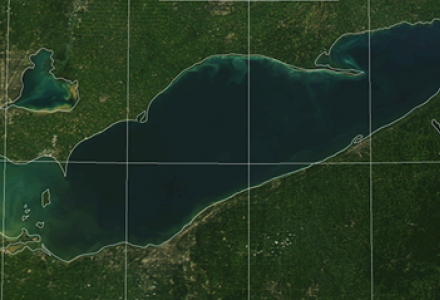
In the course of traditional environmental research projects, field work happens in the summer, sample processing and analysis take place in the winter, results are presented at scientific conferences the following year, and eventually are published in journal articles. This paradigm has shifted for harmful algal bloom researchers in Lake Erie. Stakeholders, funding agencies, and the media are coming to expect instant access to continuous observations from in-lake sensors, and access within hours to processed satellite images, laboratory test results, and model outputs.
This use of research data for guiding operational decisions presents logistical, organizational, legal, and ethical challenges. With little time for quality control, discussion with collaborators, or interpretation, preliminary research data and real-time observations have the potential to be read the wrong way by beach managers, charter fishing boat captains, or even operators of drinking water plants.
A network of algal bloom buoys and fixed instruments supported by permanent maintenance staff, vessels, and funding does not exist, unlike networks of instruments used for weather forecasting and navigation (think Doppler radar or Coast Guard channel markers). Because of this, researchers feel pressure to divert their energies away from performing experiments, developing new techniques, and mentoring students, to collect and communicate more routine monitoring data.
A variety of innovative data delivery methods are being used by researchers who study Lake Erie harmful algal blooms (HABs) to provide timely updates to stakeholders on changing conditions, while leaving more time to take care of other important responsibilities. There are related developments in effective HABs data sharing and communication with non-experts from locations beyond the Great Lakes.
Scientists are expected to collaborate closely with experts from outside their institutions and disciplines, and interact regularly and communicate clearly with reporters who want to know about their latest findings. Researchers who study environmental phenomena that potentially impact human health, such toxic algal blooms, are particularly in demand. Audiences that may include resource managers and the general public, however, require information in different forms than academic colleagues and graduate students.

What’s at stake? Human, pet, livestock, and ecosystem health; tourism revenue; and the reputations of cities, states, institutions, and the researchers themselves hang in the balance. Putting out “bad” information than is incorrect or incomprehensible can put people and careers at risk.
What’s working well? Given the demands of the 24-hour news cycle, Web-based delivery of data and background material such as fact sheets, video clips, animations, and blog entries makes current information and context available to reporters and consumers whenever they want it -- even if their local HABs researcher is unreachable when the latest bloom strikes.
The most current information on Lake Erie HABs is being provided by a loose collaboration of federal, state, and provincial agencies (the National Oceanic and Atmospheric Administration, the Ohio Environmental Protection Agency, Sea Grant), universities (Heidelberg, Michigan, Ohio State, Toledo), drinking water utilities, nonprofits (Great Lakes Observing System), and private companies (Fondriest, LimnoTech). This group shares data and forecasts with each other and the United States and Canadian public in the form of map-based Web portals and automatically emailed forecast sheets and spreadsheets. Similar systems exist in Ontario, New England, the Gulf of Mexico, California, and Australia, among other locations.

What’s not working? Competition among media outlets and research groups can create pressure to sensationalize HABs stories, or share hypotheses or data interpretations prematurely. Information that is too technical, outdated, incorrect, vague, or conflicting can confuse listeners, readers, and viewers. Other problems with the information delivery system for HABs include a lack of clear authority for any one source (unlike the National Hurricane Center, for example), erratic funding for research and communication, the challenge of reaching diverse audiences, and time constraints on researchers and reporters.
For now, the Internet and email lists are helping to provide information to media outlets and the public, and take some of the pressure off of researchers. This can’t yet replace the demand, however, for on-the-water, at-the-shore, or in-the-lab interview footage of scientists in action. And maybe it’s good to see the people behind the data from time-to-time.
In the final analysis, the questions surrounding toxic algal blooms often come down to risk communication and empowering non-experts to make their own informed decisions. As with a family doctor or a trusted auto mechanic, it helps to hear directly from those who know what they are talking about, as long as they can put the technical terms and concepts into plain language.

John F. Bratton is a senior scientist with LimnoTech in Ann Arbor, Michigan, and previously worked for 17 years as a federal research manager and environmental scientist. He has also taught many courses as a part-time professor in Michigan and Massachusetts.




